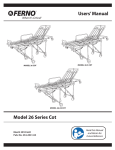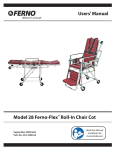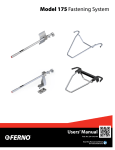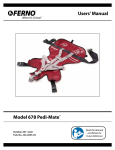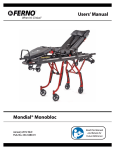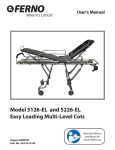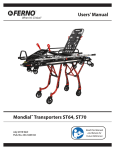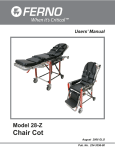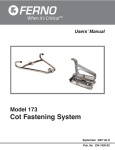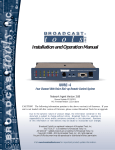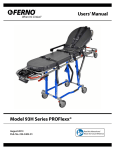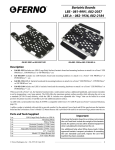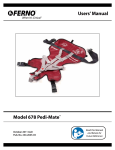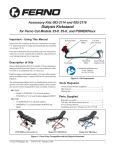Download Stat Trac® Cot Fastening System
Transcript
Combined Users’ Manual and Installation Manual Model 185, 185-MT, 185-LT Stat Trac® Cot Fastening System April 2013 Pub. No. 234-2132-04 Read this Manual and Retain for Future Reference Combined Stat Trac® Users’ & Installation Manual Ferno Technical Support Customer service and product support are important aspects of each Ferno product. Please have the product serial number available when calling, and include it in all written communications. For technical support questions: Telephone (Toll-free) 1.800.733.3766 ext. 1010 Telephone 1.937.382.1451 ext. 1010 [email protected] users’ manual To request additional free users’ manuals, contact Ferno Customer Relations, your Ferno distributor, or visit www.ferno.com. Ferno Customer Relations For ordering assistance or general information: Canada and the U.S.A. Telephone (Toll-free) 1.877.733.0911 Telephone 1.937.382.1451 Fax (Toll-free) 1.888.388.1349 Fax1.937.382.1191 Internetwww.ferno.com All Other Locations For assistance or information, please contact your Ferno distributor. If you do not have a Ferno distributor, please contact Ferno Customer Relations: Ferno-Washington, Inc., 70 Weil Way Wilmington, Ohio 45177-9371, U.S.A. Telephone +1.937.382.1451 Fax+1.937.382.6569 Internetwww.ferno.com Serial Number _________________________ Location: Inside the track, near the funnel Disclaimer This manual contains general instructions for the use, operation and care of this product. The instructions are not all-inclusive. Safe and proper use of this product is solely at the discretion of the user. Safety information is included as a service to the user. All other safety measures taken by the user should be within and under consideration of applicable regulations. It is recommended that training on the proper use of this product be provided before using this product in an actual situation. Retain this manual for future reference. Include it with the product in the event of transfer to new users. Additional free copies are available upon request from Customer Relations. Proprietary Notice The information disclosed in this manual is the property of FernoWashington, Inc., Wilmington, Ohio, USA. Ferno-Washington, Inc. reserves all patent rights, proprietary design rights, manufacturing rights, reproduction use rights, and sales use rights thereto, and to any article disclosed therein except to the extent those rights are expressly granted to others or where not applicable to vendor proprietary parts. Limited Warranty Statement The products sold by Ferno are covered by a limited warranty, which is printed on all Ferno invoices. The complete terms and conditions of the limited warranty, and the limitations of liability and disclaimers, are also available upon request by calling Ferno at 1.800.733.3766 or 1.937.382.1451. 2 © Ferno-Washington, Inc 234-2132-04 April 2013 Combined Stat Trac® Users’ & Installation Manual Table of Contents Users’ Manual_______________________________ 1-16 Installation Manual_________________________ 17-40 SectionPage Ferno Technical Support________________________ 2 Ferno Customer Relations______________________ 2 1 - Safety Information___________________________ 4 1.1Warning________________________________ 4 1.2Important_______________________________ 4 1.3Tip_____________________________________ 4 1.4 Bloodborne Disease Notice_________________ 4 1.5 Cot and Fastening System Compatibility______ 4 1.6 Symbol Glossary__________________________ 4 1.7 Responsibility of User to Maintain a Safe Fastening System____________________ 5 2 - Operator Skills and Training___________________ 6 2.1Skills___________________________________ 6 2.2Training_________________________________ 6 3 - About the Stat Trac___________________________ 6 3.1Description______________________________ 6 3.2 Compatible Cots/Transporters_______________ 7 3.3 General Specifications_____________________ 7 3.4 Using This Manual________________________ 7 3.5 Before Using the Stat Trac__________________ 7 3.6Components_____________________________ 8 4 - Features____________________________________ 9 4.1 Mounting Handle_________________________ 9 4.2 Cot Lock, Cot Release Handle______________ 10 4.3 Safety Stop_____________________________ 10 5 - Using the Stat Trac__________________________ 11 5.1 Compatible Cots_________________________ 11 5.2 Loading a Cot___________________________ 11 5.3 Unloading a Cot_________________________ 12 6 - Maintenance_______________________________ 13 6.1 Maintenance Schedule___________________ 13 6.2 Disinfecting the Stat Trac__________________ 13 6.3 Cleaning the Stat Trac____________________ 13 6.4 Inspecting the Stat Trac___________________ 14 Training Record_______________________________ 15 Maintenance Record___________________________ 16 SectionPage 1 - Safety Information__________________________ 18 1.1Warning_______________________________ 18 1.2Important______________________________ 18 1.3Tip____________________________________ 18 1.4 Cot and Fastening System Compatibility_____ 18 2 - About the Stat Trac__________________________ 19 2.1Description_____________________________ 19 2.2 Compatible Cots/Transporters______________ 19 2.3 General Specifications____________________ 19 2.4 Items Required: Model 185 Only____________ 20 2.5 Items Required: Model 185-MT, Model 185-LT___ 20 2.6Components____________________________ 21 3 - Before You Begin____________________________ 22 3.1 Installation Requirements_________________ 22 3.2 Backing Plate Requirements_______________ 23 4 - Marking the Floor___________________________ 24 4.1 Using this Section________________________ 24 4.2 Finding the Centerline____________________ 24 4.3 Positioning For Any Model Stat Trac Using a Template________________________ 25 4.4 Measuring for the Model 185 (Short) Stat Trac®_________________________ 26 4.5 Measuring for the Model 185-MT Medium) Stat Trac®_______________________ 27 4.6 Measuring for the Model 185-LT (Long) Stat Trac®_________________________ 28 5 - Installing the Stat Trac_______________________ 29 5.1 Drilling the Holes________________________ 29 5.2 Cutting Cavities for the Mounting Blocks_____ 30 5.3 Placing the Mounting Blocks_______________ 31 5.4 Installing the Mounting Blocks_____________ 32 5.5 Checking the Stat Trac With the Ambulance Floor_________________ 33 5.6 Adjusting the Fastener Posts_______________ 34 5.7 Adjusting the Fastener-Post Brackets________ 35 6 - Troubleshooting____________________________ 36 6.1 Troubleshooting Table____________________ 36 7 - Parts and Service, Accessories_________________ 37 7.1 U.S.A. and Canada_______________________ 37 7.2Worldwide_____________________________ 37 7.3 Retrofitting a Cot for Stat Trac______________ 37 7.4Accessories_____________________________ 37 Notes_____________________________________ 38-39 © Ferno-Washington, Inc 234-2132-04 April 2013 3 Stat Trac® Users’ Manual Safety Information Stat Trac® Users’ Manual 1 - Safety Information 1.1Warning 1.4Bloodborne Disease Notice Warning notices indicate a potentially hazardous situation which, if not avoided, could result in injury or death. To reduce the risk of exposure to bloodborne diseases such as HIV-1 and hepatitis when using the Stat Trac® follow the disinfecting and cleaning instructions in this manual. Warning Improper or inadequate installation can cause injury. The installer should test your fastening system setup to meet or exceed all applicable guidelines. A Stat Trac installed without backing plates can fail in a crash. Use properly installed backing plates to secure the Stat Trac at all mounting points. Improperly installed backing plates can fail in a crash. Secure the backing plates to primary structural members of the ambulance at all mounting points. Untrained operators can cause injury or be injured. Permit only trained personnel to operate the Stat Trac. Improper use can cause injury. Use the Stat Trac only for the purpose described in this manual. An improper cot can cause injury. Use only Ferno cots designed or properly modified for use with the Stat Trac. Improper operation can cause injury. Operate the Stat Trac only as described in this manual. Improper maintenance can cause injury. Maintain the Stat Trac only as described in this manual. 1.5 Cot and Fastening System Compatibility Note: For the purpose of this notice, all Ferno® transporters are included under the generic term, “cot.” Combining different manufacturers’ products into a “mixedcomponent” cot/cot fastening system can increase the user’s risk of injury and damage. Ferno-Washington, Inc. strongly recommends that only Ferno-manufactured cots be used in Ferno-manufactured cot fastening systems, and that only Ferno-manufactured cot fastening systems be used for securing Ferno-manufactured cots in ambulances. ANY COMBINATION OF A FERNO COT OR COT FASTENING SYSTEM WITH A NON-FERNO COT OR COT FASTENING SYSTEM IS MISUSE OF THE FERNO PRODUCT. Responsibility for the outcome of known, intentional misuse rests squarely on the misuser. 1.6 Symbol Glossary 1.2Important Important notices emphasize important usage or maintenance information. Failure to follow Important notices could result in damage to the product or property damage. The symbols defined below are used on the Stat Trac® and/ or in this users’ manual. Ferno uses symbols recognized by the International Standards Organization (ISO), American National Standards Institute (ANSI) and the emergency medical services industry. Important 1.3Tip General Warning of Potential Injury Read the Users’ Manual Tips provide recommendations for easier use of the product. Product meets European Union Standards 4 Unlocked Locked © Ferno-Washington, Inc 234-2132-04 April 2013 Stat Trac® Users’ Manual Safety Information 1.7 Responsibility of User to Maintain a Safe Fastening System The Ferno® Stat Trac® Cot Fastening System is designed to securely hold an ambulance cot inside a ground-based ambulance. Warning Improper or inadequate installation can cause injury. The installer should test your fastening system setup to meet or exceed all applicable guidelines. It has been designed and tested by Ferno to meet or exceed existing ambulance standards from: ● Ambulance Manufacturer’s Division (AMD) of the National Truck Equipment Association. ● Federal Ambulance Specification KKK-A-1822. Warning A Stat Trac installed without backing plates can fail in a crash. Use properly installed backing plates to secure the Stat Trac at all mounting points. Note: AMD and KKK-A-1822 standards are updated periodically. Current guidelines are available from these organizations. See page 6. The integrity of the fastening system relies heavily on the installer to secure the fastening system to the ambulance in a way that meets or exceeds these guidelines (See the Installation Manual for details). Also, the integrity of the fastening system relies on the user to regularly inspect and maintain the system. Warning Improperly installed backing plates can fail in a crash. Secure the backing plates to primary structural members of the ambulance at all mounting points. Ferno’s Stat Trac Cot Fastening System, when installed and maintained properly, meet or exceed all applicable KKK-A-1822 specifications and AMD standards. To help the user achieve a compliant system, Ferno strongly recommends: user: 1. Inspect the fastening system a minimum of once each month, or more often with frequent use. Check under the ambulance to see if exposure to the environment has damaged the backing plates, nuts or bolts. Make sure the nuts are tight and secure, while observing Point 2, below. Replace the fastening system if its integrity is in question. 2. During inspections, make sure all fastening system components are tight, however, do not repeatedly tighten the bolts with powered equipment. Over time, using powered tools to repeatedly tighten connections can cause damage to the fastening system by compressing the nut and bolt through the backing plate. If inspection indicates the components are “pulling through” the backing plate, immediately take the ambulance out of service and install a new fastening system with new backing plates. 3. Consult your installer to ensure your fastening system meets all applicable standards. The installer’s responsibility includes installing a test fastening system in the same manner as the fastening systems are to be installed on your ambulance(s) and testing this setup to meet or exceed the pull test stipulated in AMD .004. Your installer should be able to show that your fastening system setup is equal to a setup that passes this test. 4. Make sure your fastening system has been installed with backing plates beneath the ambulance floor at all mounting points. If the backing plates are not present, immediately take the ambulance out of service and have a new fastening system with backing plates installed. © Ferno-Washington, Inc 234-2132-04 April 2013 5 Stat Trac® Users’ Manual Operator Skills & Training, About the Stat Trac 2 - Operator Skills and Training 2.1Skills Operators using the Stat Trac need: ● a working knowledge of emergency patient-handling procedures. ● a complete understanding of the procedures described in this manual. 2.2Training Warning Operator trainees need to: ● read and understand this manual. ● be trained on the use of the Stat Trac. ● practice with the Stat Trac before using it with a patient. ● record their training information. A sample training record sheet is provided on page 15. Untrained operators can cause injury or be injured. Permit only trained personnel to operate the Stat Trac. 3 - About the Stat Trac 3.1Description Models 185, 185-MT and 185-LT Stat Trac® Cot Fastening Systems (referred to as the Stat Trac in this manual) are devices designed to secure a Ferno cot or transporter inside a ground-based ambulance. See Cot and Fastening System Compatibility, page 4, for more information. Each Stat Trac is sold with one track and one Combined Users’ and Installation Manual. Installation kits are sold separately. Stat Trac features include: ● Wide-Angle Funnel: makes loading cots easy ● Track Loading: allows straight-in cot loading without cot drift ● Safety Stop: holds cot secure inside ambulance while operators unlock the undercarriage during the loading and unloading process ● Single-Hand Cot Release ● Aluminum shell: impact resistant, easy to clean ● Easy Removal: for cleaning The Stat Trac is for professional use only. Ferno strongly recommends that the Stat Trac is installed according to AMD (Ambulance Manufacturer’s Division) guidelines. See the Installation Manual for more information. It is designed for use with ambulances that meet the requirements of the Federal Ambulance Specification KKK-A-1822. 6 Warning Improper use can cause injury. Use the Stat Trac only for the purpose described in this manual. contacts for industry standards For information about Federal Ambulance Specification KKK-A-1822, contact: Federal Supply Services Specifications Section Suite 8100 470 E. L’Enfant Plaza, SW Washington, DC 20407 For information about AMD standards, contact: Ambulance Manufacturer’s Division National Truck Equipment Association 37400 Hills Tech Drive Farmington Hills, MI, 48331-3414 © Ferno-Washington, Inc 234-2132-04 April 2013 Stat Trac® Users’ Manual About the Stat Trac 3.2 Compatible Cots/Transporters The Stat Trac is for use with the following Ferno cots that have been designed specifically for use with the Stat Trac: ● POWERFlexx-ST® ● PROFlexx® Series 35PST, 35XST, 93PST, 93HST ● 35A-ST, 35A+ST, 93ES-ST, 93EX-ST, and XCalibur (if factory-equipped). Warning An improper cot can cause injury. Use only Ferno cots designed or properly modified for use with the Stat Trac. Adaptor kits are available to modify Ferno Series 35A, 35A+, 35P, 93ES, 93EX, 93H, POWERFlexx® and XCalibur (if not factory-equipped) for use with the Stat Trac. 3.3General Specifications Specifications are rounded to whole numbers. Contact Ferno Customer Relations for additional information (page 2). Ferno reserves the right to change specifications without notice. Stat Trac Change In 2012, the Stat Trac changed from plastic to aluminum sides. The function of the Stat Trac is identical. Only the weight and appearance changed. Specification Imperial Metric 86 in 2184 mm Model 185-MT 96 in 2438 mm Model 185-LT 103 in 2616 mm 8 in 203 mm 3 in 76 mm Model 185 55 lb 24.9 kg Model 185-MT 61 lb 27.7 kg Model 185-LT 65 lb 29.5 kg Length Model 185 Width Overall 3.4 Using This Manual In this manual, the term Stat Trac is used to refer to all models of the Stat Trac. When differences exist, the specific model name (Model 185, Model 185-MT or Model 185-LT) is used. 3.5Before Using the Stat Trac To install the Stat Trac, refer to the Installation Manual, pages 17-40. As a user, be aware of the following: ● In the USA, the ambulance must comply with the current version of Federal Ambulance Specification KKK-A-1822. ● Stat Trac installation requires the use of backing plates beneath the ambulance floor at all mounting points. If your ambulance does not have the required backing plates, have them installed. ● Inspect the Stat Trac regularly to ensure it meets all required standards required by your local government. See Inspecting the Stat Trac, page 14. ● Install a new Stat Trac when remounting an ambulance box. Removing and reinstalling an old Stat Trac can weaken the Stat Trac. ● Height Overall Weight Important Owners of cots in the PROFlexx®, POWERFlexx®, and XCalibur series: Cots with 6”/152 mm wheels require the Stat Trac to be installed at least 17”/431.8 mm from the side walls. Installing closer than 17”/431.8 mm may not allow clearance for the wheels to swivel during transporter removal. If you installed a Stat Trac at the old minimum distance prior to June 1, 2000, you must adjust your Stat Trac to the new 17”/431.8 mm minimum wall clearance. Center-mounted Stat Tracs and those installed 17”/431.8 mm or more from the wall do not require adjustment. Follow the instructions on pages 17-40 of this manual for proper installation. Replace the Stat Trac if the ambulance is involved in a traffic accident. © Ferno-Washington, Inc 234-2132-04 April 2013 7 Stat Trac® Users’ Manual About the Stat Trac 3.6Components Fastener Post (2) Fastener Post (3) Fastener Post (3) Length Comparison (Top to Bottom): Model 185, Model 185-MT, Model 185-LT Mounting Handle Safety Stop Bumper Funnel Cot Lock Cot Release Handle The Components are Common to All Models The Only Variation is the Distance of the Components from the Funnel 8 © Ferno-Washington, Inc 234-2132-04 April 2013 Stat Trac® Users’ Manual Features 4 - Features 4.1 Mounting Handle The mounting handle locks the Stat Trac in the ambulance. It is also designed to stop a cot from being loaded when the Stat Trac is not completely secured to the floor. If the cot will not load into the Stat Trac, make sure the mounting handle is engaged. See Troubleshooting, page 36. To mount the Stat Trac to the ambulance floor: Fastener Post (2 or 3) 1. Slide the Stat Trac toward the front of the ambulance so that each fastener post slides into its mounting block (Figure 1). 2. To lock the Stat Trac in place, swing the mounting handle down and toward the safety stop (Figure 2) until it is parallel with the floor. 3. Verify that the Stat Trac is locked before use. To do this, pull on the track with your hands. The Stat Trac should remain firmly in place. Mounting Block (2 or 3) Figure 1 - Mounting the Stat Trac To un-mount the Stat Trac from the ambulance floor: 1. Swing the mounting handle upward, toward the cot lock, to release the Stat Trac from the mounting blocks (Figure 2). 2. Pull the Stat Trac toward the rear of the ambulance to remove it. Mounting Handle Figure 2 - Using the Mounting Handle © Ferno-Washington, Inc 234-2132-04 April 2013 9 Stat Trac® Users’ Manual Features 4.2 Cot Lock, Cot Release Handle Cot Lock The cot lock (Figure 3) holds the cot securely in the Stat Trac during transport in an ambulance and prevents the cot from being removed from the Stat Trac. To engage the cot in the cot lock, load the cot into the Stat Trac and slide the foot-end loading post to the left, into the cot lock. To disengage the cot lock, simultaneously pull the cot release handle toward the rear of the ambulance (Figure 3) and pull the cot to the right to position the foot-end loading post in the center of the channel. Cot Release Handle Figure 3 - Cot Release Handle For complete unloading instructions, see Unloading a Cot, page 12. 4.3 Safety Stop The safety stop (Figure 4) holds the head end of the cot securely in the ambulance while the operators unlock the undercarriage during loading or unloading. At the proper time, the head-end operator uses the release mechanism on the cot to disable the safety stop. Safety Stop For complete loading and unloading instructions, see Section 5, Using the Stat Trac, pages 11-12. using the safety stop during loading When loading a cot into the ambulance, the operators: 1. Roll the loading end of the cot into the Stat Trac until the head-end loading post passes the safety stop. 2. Roll the cot out of the ambulance until it stops on the safety stop. This verifies the cot is being held by the safety stop. using the safety stop during unloading When unloading a cot from the ambulance, pull the cot out of the ambulance until the safety stop catches the cot’s headend loading post. 10 Figure 4 - Safety Stop Engaging the Safety Stop The safety stop holds the cot secure while the operators unlock and raise or lower the undercarriage during loading and unloading. During cot loading and unloading, the operators should roll the cot firmly against the safety stop to verify that the cot is held securely. This safety step confirms to the operators that they are using the Stat Trac and cot properly. © Ferno-Washington, Inc 234-2132-04 April 2013 Stat Trac® Users’ Manual Using the Stat Trac 5 - Using the Stat Trac 5.1 Compatible Cots The Stat Trac is for use only with Ferno® cots and transporters. See Cot and Fastening System Compatibility, page 4, and Compatible Cots/Transporters, page 7. Warning Improper operation can cause injury. Operate the Stat Trac only as described in this manual. Warning An improper cot can cause injury. Use only Ferno cots designed or properly modified for use with the Stat Trac. 5.2 Loading a Cot To secure a cot in the Stat Trac: 1. If the ambulance has a folding step bumper, raise it. 2. Place the cot in a loading position (see the cot Users’ Manual for instructions). 3. Roll the cot to the open rear doors of the ambulance and align the head-end loading post on the cot with the Stat Trac (Figure 5). 4. Using the Stat Trac funnel as a guide, roll the cot into the ambulance until the head-end loading post passes the safety stop. 5. Roll the cot out of the ambulance until it stops against the safety stop. This verifies the cot is held securely before the operators unlock the undercarriage. Cot Head-End Loading Post Figure 5 - Loading Post Aligned for Loading 6. Keeping the cot level with the ambulance floor, fold the cot undercarriage as instructed in the cot Users’ Manual and begin pushing the cot into the ambulance and Stat Trac. 7. While keeping the cot level with the ambulance floor, align the cot’s foot-end loading post with the funnel and push the cot into the Stat Trac as far as possible. 8. Slide the foot end of the cot to the left to engage the foot-end loading post in the cot lock (Figure 6). Figure 6 - Locking the Cot in the Stat Trac © Ferno-Washington, Inc 234-2132-04 April 2013 11 Using the Stat Trac Stat Trac® Users’ Manual 5.3 Unloading a Cot To release a cot from the Stat Trac: 1. If the ambulance has a folding step bumper, raise it. 2. Pull the cot release handle toward the rear of the ambulance (Figure 7) and slide the foot-end of the cot to the right to free it from the cot lock. 3. Both Operators: Pull the cot out of the patient compartment until the safety stop engages the cot’s head-end loading post. 4. Both Operators: Follow the instructions in the cot Users’ Manual to properly unfold and lock the undercarriage of your cot. 5. Verify that the undercarriage is locked before continuing. 6. Head-End Operator: Use the fastener release lever (or fastener release handle) on the cot to disengage the cot from the safety stop (Figure 8 and Figure 9). Figure 7 - Releasing the Cot from the Stat Trac Note: The mechanism to release the cot from the Stat Trac varies from model to model. See your cot Users’ Manual for instructions. 7. While the head-end operator engages the fastener release lever/handle, both operators pull the cot out of the patient compartment to release the safety stop. Let go of the fastener release lever/handle after the headend loading post moves beyond the safety stop. Figure 8 - Using the Fastener Release Lever Figure 9 - Using the Fastener Release Handle (PROFlexx® Series Cots) 12 © Ferno-Washington, Inc 234-2132-04 April 2013 Stat Trac® Users’ Manual Maintenance 6 - Maintenance 6.1 Maintenance Schedule Warning Contact Ferno Customer Relations to order Ferno cleaners and disinfectants (page 2). Minimum Maintenance Intervals 6.2 Disinfecting the Stat Trac Disinfecting (this page) Remove the Stat Trac from the ambulance. Wipe all surfaces with a disinfectant, following the disinfectant manufacturer’s directions. Ferno recommends you inspect the Stat Trac for obvious damage as you disinfect it. Cleaning (this page) 6.3 Cleaning the Stat Trac Remove the Stat Trac from the ambulance. Wash all surfaces with a mild detergent. Use a stiff-bristled brush if necessary to remove stains. Rinse with warm water and dry with a towel. Inspecting (page 14) Each Use When using maintenance products, follow the manufacturer’s directions and read the manufacturers’ material safety data sheets. • Each Month Improper maintenance can cause injury. Maintain the Stat Trac only as described in this manual. As Needed The Stat Trac requires regular maintenance. Set up and follow a maintenance schedule. A form is provided on page 16. The chart at right represents minimum maintenance. • • • Important Disinfectants and cleaners containing bleach, phenolics, or iodines can harm the Stat Trac. Disinfect and clean the Stat Trac only with products that do not contain these chemicals. Important Using abrasive cleaning compounds or applicators on the cot can cause damage. Do not use abrasive materials to clean the cot. © Ferno-Washington, Inc 234-2132-04 April 2013 13 Maintenance 6.4 Inspecting the Stat Trac Stat Trac® Users’ Manual Important Have your service’s equipment maintenance personnel inspect the Stat Trac. Follow the checklist below and work the Stat Trac through all its functions as described in this manual. Also see the Responsibility of User to Maintain a Safe Fastening System, page 5. If the required backing plates are not present, take the Stat Trac out of service and have the backing plates installed immediately. Then, install a new Stat Trac. If the inspection indicates damage or excessive wear, see Troubleshooting, page 36. For service, see Parts and Service, page 37. Important ● Are all components present? ● Are all parts in good condition (no cracks, corrosion, or damage)? ● Do all moving parts operate smoothly and properly? ● Does the Stat Trac lock properly to the mounting blocks? ● Does the cot load and unload properly? ● Does the cot lock properly into the Stat Trac? ● Monitor the ambulance floor, including beneath the ambulance, and check the integrity of the fastening system. Is the system worn? Has exposure to the environment caused noticeable damage? ● Are the required backing plates present, and are they securely welded to a primary structural member of the ambulance floor? ● Is all the hardware tight? (Reminder: Do not repeatedly tighten the hardware.) 14 Make sure all connections are tight, but do not overtighten the hardware. Overtightening, especially with powered tools, can cause the nut and bolt beneath the ambulance floor to pull through the backing plate. If inspection indicates the components are pulling through the backing plate, take the Stat Trac out of service immediately and install a new Stat Trac with new backing plates. © Ferno-Washington, Inc 234-2132-04 April 2013 Stat Trac® Users’ Manual Training Record Date Name © Ferno-Washington, Inc 234-2132-04 April 2013 Training Method 15 Stat Trac® Users’ Manual Maintenance Record Date 16 Maintenance Performed By © Ferno-Washington, Inc 234-2132-04 April 2013 Installation Manual Model 185, 185-MT, 185-LT Stat Trac® Cot Fastening System April 2013 Pub. No. 234-2132-04 Read this Manual and Retain for Future Reference Stat Trac® Installation Manual Safety Information Stat Trac® Installation Manual 1 - Safety Information 1.1Warning 1.2Important Warning notices indicate a potentially hazardous situation which, if not avoided, could result in injury or death. Important notices emphasize important usage or maintenance information. Failure to follow Important notices could result in damage to the product or property damage. Warning Important An improper cot can cause injury. Use only Ferno cots designed or properly modified for use with the Stat Trac. Improper or inadequate installation can cause injury. The installer must test the fastening-system setup to meet or exceed all applicable guidelines before using the setup in an ambulance. Improper testing can cause injury. Installers must test the fastening-system setup to pass AMD Standard 004 before installing a Stat Trac in an ambulance. 1.3Tip Tips provide recommendations for easier use of the product. Improperly-installed backing plates can fail. Secure the backing plates to primary structural members of the ambulance at all mounting points. Improper adjustment can cause injury and damage. Do not loosen the fastener posts. If needed, adjust only the height of the fastener-post brackets. 1.4 Cot and Fastening System Compatibility Improper parts and service can cause injury. Use only Ferno-approved parts and Ferno-approved service on the Stat Trac. Note: For the purpose of this notice, all Ferno® transporters are included under the generic term, “cot.” Modifying the Stat Trac can cause injury and damage. Use the Stat Trac only as designed by Ferno. Combining different manufacturers’ products into a “mixedcomponent” cot/cot fastening system can increase the user’s risk of injury and damage. Ferno-Washington, Inc. strongly recommends that only Ferno-manufactured cots be used in Ferno-manufactured cot fastening systems, and that only Ferno-manufactured cot fastening systems be used for securing Ferno-manufactured cots in ambulances. ANY COMBINATION OF A FERNO COT OR COT FASTENING SYSTEM WITH A NON-FERNO COT OR COT FASTENING SYSTEM IS MISUSE OF THE FERNO PRODUCT. Responsibility for the outcome of known, intentional misuse rests squarely on the misuser. 18 © Ferno-Washington, Inc 234-2132-04 April 2013 Stat Trac® Installation Manual About the Stat Trac 2 - About the Stat Trac 2.1Description Model 185, Model 185-MT and Model 185-LT Stat Trac® Cot Fastening Systems (referred to as the Stat Trac in this manual) are devices designed to secure a Ferno cot or mobile transporter inside a ground-based ambulance. See Cot and Fastening System Compatibility, page 18, for more information. Each Stat Trac is sold with one track and one Combined Users’ and Installation Manual. Installation kits are sold separately. The Stat Trac is for professional use only. It is designed for use with ambulances that meet the requirements of the Federal Ambulance Specification KKK-A-1822. For information about Federal Ambulance Specification KKK-A-1822, see Contacts for Industry Standards, page 23. Important Owners of cots in the PROFlexx®, POWERFlexx®, and XCalibur series: Cots with 6”/152 mm wheels require the Stat Trac to be installed at least 17”/431.8 mm from the side walls. Installing closer than 17”/431.8 mm may not allow clearance for the wheels to swivel during transporter removal. If you installed a Stat Trac at the old minimum distance prior to June 1, 2000, you must adjust your Stat Trac to the new 17”/431.8 mm minimum wall clearance. Center-mounted Stat Tracs and those installed 17”/431.8 mm or more from the wall do not require adjustment. Follow the instructions on pages 17-40 of this manual for proper installation. 2.2 Compatible Cots/Transporters The Stat Trac is for use with the following Ferno cots that have been designed specifically for use with the Stat Trac: ● POWERFlexx-ST® ● PROFlexx® Series 35PST, 35XST, 93PST, 93HST ● 35A-ST, 35A+ST, 93ES-ST, 93EX-ST, and XCalibur (if factory-equipped). Warning An improper cot can cause injury. Use only Ferno cots designed or properly modified for use with the Stat Trac. Adaptor kits are available to modify Ferno Series 35A, 35A+, 35P, 93ES, 93EX, 93H, POWERFlexx® and XCalibur (if not factory-equipped) for use with the Stat Trac. 2.3General Specifications Specifications are rounded to whole numbers. Contact Ferno Customer Relations for additional information (page 2). Ferno reserves the right to change specifications without notice. Specification Imperial Metric 86 in 2184 mm Model 185-MT 96 in 2438 mm Model 185-LT 103 in 2616 mm 8 in 203 mm 3 in 76 mm Model 185 55 lb 24.9 kg Model 185-MT 61 lb 27.7 kg Model 185-LT 65 lb 29.5 kg Length Model 185 Width Overall Height Overall Weight © Ferno-Washington, Inc 234-2132-04 April 2013 19 About the Stat Trac 2.4 Items Required: Model 185 Only The following items (not supplied) are required to install the Model 185 Stat Trac: Mounting block (2 ea.) Order kit 056-7027 Beauty Shim plate (2 ea., may be needed) Order kit 056-7027 Backing (anchor) plates* 2 ea. 3/8" SAE Grade 5, UNC 2, Zinc-plated socket head cap screws** 8 ea. 3/8" SAE Grade 5, UNC 2, Zinc-plated elastic lock nuts** 8 ea. 3/8" Drill bit 1 ea. 1/8" Drill bit 1 ea. 1/8" Socket head wrench 1 ea. 3/8" Box wrench 1 ea. Tube of silicone caulking 1 ea. Router or saber saw 1 ea. Template Model 185 (optional) Order kit 081-9539 * The Stat Trac is designed to be installed with, at minimum: A36 Grade steel backing plates, 6061-T6 Grade aluminum backing plates, or equivalent at all mounting points. (See Backing Plate Requirements, page 23 for more information). If the vehicle in which you are installing the Stat Trac does not have the required backing plates or their equivalent, have them installed. Consult the ambulance manufacturer for installation information. ** The socket head cap screws and nuts should be of at least SAE Grade 5, with a corrosion-resistant coating (zinc plating recommended) and a UNC-2 threading. The length of the screws will be determined by the combined thickness of the patient compartment floor, the mounting block, any shim plates used, and the backing plate. When installed, the cap screws should extend beyond the backing plates a minimum of 3/4"/19 mm. Note: To order the required mounting kit or an optional Installation Template, see Accessories, page 37. Stat Trac® Installation Manual 2.5 Items Required: Model 185-MT, Model 185-LT The following items (not supplied) are required to install the Model 185-MT and 185-LT Stat Trac: Mounting blocks (3 ea.) Beauty Shim plates (3 ea., may be needed) Backing (anchor) plates* 3/8" SAE Grade 5, UNC 2, Zinc-plated socket head cap screws** 3/8" SAE Grade 5, UNC 2, Zinc-plated elastic lock nuts** 3/8" Drill bit 1/8" Drill bit 3/8" Socket head wrench 3/8" Box wrench Tube of silicone caulking Router or saber saw Template Model 185-MT (optional) Template Model 185-LT (optional) Order kit 056-7030 Order kit 056-7030 3 ea. 12 ea. 12 ea. 1 ea. 1 ea. 1 ea. 1 ea. 1 ea. 1 ea. Order kit 081-9875 Order kit 081-9543 * The Stat Trac is designed to be installed with, at minimum: A36 Grade steel backing plates, 6061-T6 Grade aluminum backing plates, or equivalent at all mounting points. (See Backing Plate Requirements, page 23 for more information). If the vehicle in which you are installing the Stat Trac does not have the required backing plates or their equivalent, have them installed. Consult the ambulance manufacturer for installation information. ** The socket head cap screws and nuts should be of at least SAE Grade 5, with a corrosion-resistant coating (zinc plating recommended) and a UNC-2 threading. The length of the screws will be determined by the combined thickness of the patient compartment floor, the mounting block, any shim plates used, and the backing plate. When installed, the cap screws should extend beyond the backing plates a minimum of 3/4"/19 mm. Note: To order the required mounting kit or an optional Installation Template, see Accessories, page 37. 20 © Ferno-Washington, Inc 234-2132-04 April 2013 Stat Trac® Installation Manual About the Stat Trac 2.6Components Model 185 Components 185 Stat Trac Installation Template Accessory Kit 081-9539 for 185 Mounting Kit 056-7027 (Required) 2 - Mounting Blocks 2 - Beauty Shim Plates (.030 thick) Backing Plate (2 required, not supplied) Model 185-MT and Model 185-LT Components 185-MT Stat Trac Backing Plate (3 required, not supplied) 185-LT Stat Trac Installation Template Accessory Kit 081-9875 for 185-MT Accessory Kit 081-9543 for 185-LT © Ferno-Washington, Inc 234-2132-04 April 2013 Mounting Kit 056-7030 (Required): 3 -Mounting Blocks 3 - Beauty Shim Plates (.030 thick) 21 Stat Trac® Installation Manual Before You Begin 3 - Before You Begin 3.1 Installation Requirements installer requirement The integrity of the cot-fastening system relies on the installer to mount the Stat Trac to meet or exceed the AMD standards and KKK-A-1822 guidelines. Installers must confirm the validity of their installation method by mounting and pull-testing a cot fastening system separate from an ambulance. Before mounting a Stat Trac in an ambulance, install a test Stat Trac fastening system and test this setup to meet or exceed the pull test specified in AMD 004. When the setup has passed this test, use the same setup when installing new Stat Trac(s) in your ambulance(s). For more information, see Contacts for Industry Standards, page 23. general requirements ● To install the Stat Trac, a skilled professional who is familiar with ambulance construction is required. ● Install the Stat Trac to meet or exceed all applicable standards in your country. ● Properly-installed backing plates (not supplied) must be used at all mounting points. See Backing Plate Requirements, page 23. Warning Improper or inadequate installation can cause injury. The installer must test the fastening-system setup to meet or exceed all applicable guidelines before using the setup in an ambulance. Warning Improper testing can cause injury. Installers must test the fastening-system setup to pass AMD 004 before installing a Stat Trac in an ambulance. Warning A Stat Trac installed without backing plates can fail. Secure the Stat Trac to properly-installed backing plates at all mounting points. Warning Improperly-installed backing plates can fail. Secure the backing plates to primary structural members of the ambulance at all mounting points. Vehicle Requirements ● Consult the ambulance manufacturer for ambulance structural details and ambulance warranty information. ● Inspect the ambulance for anything that might interfere with the installation. ● The floor to which the mounting components are attached must have sufficient strength to hold the mounted Stat Trac and cot with patient. ● Install a new Stat Trac when remounting an ambulance box. ● If the ambulance is involved in a traffic accident, the Stat Trac could sustain hidden damage (damage that is not visible to the eye). Replace the Stat Trac if the ambulance is involved in a traffic accident. ● The ambulance bumper extension should not exceed 14" (356 mm). The patient compartment should have a level floor large enough for the folded cot and cot Stat Trac. See the cot users’ manual for details. Important The Stat Trac is designed to be installed with backing plates welded to rigid structural frame members at all mounting points. See Specification KKK-A-1822, Section 3.10.6 and the instructions in this manual. Important Inspect under the floor and behind the wall of the ambulance for anything (fuel tank, wiring, brake lines, fuel lines, oxygen lines or other items) that might interfere with the installation. Important If the ambulance is involved in a traffic accident, replace the Stat Trac. 22 © Ferno-Washington, Inc 234-2132-04 April 2013 Stat Trac® Installation Manual 3.2Backing Plate Requirements ● Backing plates must be used at all mounting points. ● Backing plates must be ASTM A36 grade steel, aluminum 6061-T6, or equivalent (minimum). ● At all mounting points, the backing plates must be large enough to be welded at both ends to a rigid structural frame or structural reinforcement of the ambulance. See Table 1 below for recommendations. Ferno’s recommendations do not replace the need to test your fastening system setup. ● At all mounting points, use a full penetration weld to secure the backing plates to the rigid structural frame members. Spot-welding is not sufficient for a quality installation. Before You Begin contacts for industry standards For information about Federal Ambulance Specification KKK-A-1822, contact: Federal Supply Services Specifications Section Suite 8100 470 E. L’Enfant Plaza, SW Washington, DC 20407 For information about AMD standards, contact: Ambulance Manufacturer’s Division National Truck Equipment Association 37400 Hills Tech Drive Farmington Hills, MI, 48331-3414 Install backing plates on the ambulance if none are present. Contact the ambulance manufacturer for installation information. table 1 - recommended minimum backing plates Thickness and Style A36 Steel 6061-T6 Aluminum Less than 9" (229 mm) 1/2" (13 mm) plate 9"-21" (229-533 mm) 3/4" (19 mm) plate 21"-38" (533-965 mm) 1" (25 mm) plate 38"-54" (965-1372 mm) Structural C-channel, 7.25 lb/ft, 1.721" legs, 0.321" flange Less than 6" (152 mm) 1/2" (13 mm) plate 6"-13" (152-330 mm) 3/4" (19 mm) plate 13"-24" (330-610 mm) 1" (25 mm) plate Width Length Sufficient to span the distance between two rigid structural frame members Recommended Minimum* Backing Plate 4" (102 mm) Span Between Two Rigid Structural Frame Members Note: (*) These recommendations are guidelines. Test your fastening system setup to meet or exceed all applicable standards. Contact your ambulance manufacturer for installation assistance and for alternate materials of equal or greater strength. Important Important The Stat Trac is designed to be installed with backing plates welded to rigid structural frame members at all mounting points. See Contacts for Industry Standards above. Ambulance construction varies widely. Ferno’s backing-plate recommendations do not replace the installer’s requirement to test the setup to meet or exceed all applicable standards. © Ferno-Washington, Inc 234-2132-04 April 2013 23 Stat Trac® Installation Manual Marking the Floor 4 - Marking the Floor 4.1 Using this Section Center-mounted (Stat Trac in Center of patient compartment) Use the measurements in Subsection 4.2 to begin marking the floor of the ambulance for the Stat Trac. Then, if you purchased the optional template, use Subsection 4.3, “Positioning For Any Model Stat Trac Using a Template,” to finish marking the floor. 1. Measure across the patient compartment from one side wall to the other (or to the bench seat, if present), and divide the total by two. This is the distance to the center of your patient compartment. If you do not have a template, use the appropriate measurements for your model Stat Trac in Subsections 4.4, 4.5 or 4.6 to finish marking the floor of the ambulance. 2. Starting at the patient compartment wall near the rear doors, measure toward the center of the patient compartment and mark a point at the distance you calculated in Step 1. 4.2 Finding the Centerline 3. From the same wall but near the forward end of the patient compartment, measure and mark a second point at the distance you calculated in Step 1. Items Needed: 1 1 Pen, pencil, or similar to mark the floor Measuring tape 4. Start at the rear doors and draw a line between the marks you make. This is the Centerline. Before you begin, remove the cot and any existing cot fastening system from the ambulance. Then, decide where to place the Stat Trac. Follow the instructions below to place it to one side of the ambulance, in the center of the ambulance, or prepare for dual Stat Trac mountings. LBS and LBS Jr. Customers: The width of the Large Body Surface accessories requires the Stat Trac to be mounted in the center of the vehicle. dual Stat Trac mounting If you want two Stat Trac mounting positions in the patient compartment, use one or both of the above measuring methods while following the guidelines below. When installing two Stat Trac mounting positions in a single ambulance compartment, the Centerlines: Side-mounted Stat Trac (as close as possible to one wall) 1. Starting at the patient compartment wall near the (rear) compartment doors, measure toward the center of the patient compartment and mark a point at 17 inches/432 millimeters. 2. From the same wall but near the forward end of the patient compartment, measure and mark a second point at 17 inches/432 millimeters. 3. Starting at the rear doors, draw a straight line between the 17-inch/432 millimeters marks. This will be the Centerline. 24 33 MUST BE A minimum of 17 inches/432 millimeters from the patient compartment walls1 and more than 5 inches/127 millimeters apart.2 22 CANNOT BE Between 15-20 inches/381-508 millimeters apart.3 1 Note: Each Centerline must be a minimum of 17 inches/432 millimeters from the patient compartment’s side walls to allow room between the cot wheels and wall. Note: The Centerlines must be a minimum of 5 inches/127 millimeters apart to ensure the mounting blocks or backing plates do not overlap. 2 Note: Keep the Centerlines less than 15 inches/381 millimeters apart or greater than 20 inches/508 millimeters apart to ensure the cot wheels do not rest on top of the alternate mounting blocks. 3 © Ferno-Washington, Inc 234-2132-04 April 2013 Marking the Floor Stat Trac® Installation Manual 4.3 Positioning For Any Model Stat Trac Using a Template Note: Refer to Figure 1 for these instructions. 1. Close the rear doors. 2. Mark the floor along the line where the (closed) rear doors meet the patient compartment floor. If the doors close flush with the patient compartment floor, start from this edge. 3. Use the mark on the floor at the doors’ edge and place the template at this line with the lip facing up. Or, if the doors close flush with the edge of the patient compartment floor, place the template at the edge of the floor with the lip facing down. 4. Center the template on the Centerline and inspect for any interference between the mounting block slots and the wheel plates in the patient compartment. Remove the wheel plates and any other fixtures that interfere with the mounting slots. 5. With the template on the Centerline, mark the outline of the mounting block slots on the floor. If you are installing two mounting positions in the same ambulance, repeat Steps 1-5, using the second Centerline. 17" Minimum Distance From Side Wall Template Wheel Plate (If Present) Mounting Block Slot Door Edge Mark Centerline Template Lip Figure 1 - Floor Markings Using a Template © Ferno-Washington, Inc 234-2132-04 April 2013 25 Stat Trac® Installation Manual Marking the Floor 4.4 Measuring for the Model 185 (Short) Stat Trac® Note: Refer to Figure 2 for these instructions. 1. Mark the floor along the line where the (closed) rear doors meet the patient compartment floor. If the doors close flush with the edge of the patient compartment floor, start from this edge. 2. Starting from the mark made in Step 1 (or the floor edge), measure and mark a point on each side of the Centerline at 2.26 (2-17/64) inches/57 millimeters into the patient compartment. 3. Connect the two marks made in Step 2. This line (Line A) will be the rear edge of the first mounting block. 4. Starting from the Centerline on Line A, mark a point 1.5 (1-1/2) inches/38 millimeters to each side of the Centerline. These points show the width of the first mounting block. 5. Place a mounting block on Line A with the corners on the 1.5-inch/38 millimeter marks made in Step 4. Trace the outline of the bottom edge of the mounting block. 6. Starting at Line A, measure 73.236 (73-15/64) inches/1860 millimeters into the patient compartment and mark a point on each side of the Centerline. 7. Connect the two marks made in Step 6. This line (Line B) will be the rear edge of the second mounting block. 8. Starting from the Centerline on Line B, mark a point 1.5 (1-1/2) inches/38 millimeters to each side of the Centerline. These points show the width of the second mounting block. 9. Place a mounting block on Line B with the corners on the 1.5-inch marks made in Step 8. Trace the outline of the bottom edge of the mounting block. 17.000 Minimum Centerline 3.000 7.310 First Mounting Block Outline Second Mounting Block Outline B 73.236 1.500 1.500 Ambulance Front Floor Edge or Door Edge 2.260 A Ambulance Rear Figure 2 - Floor Markings for Model 185 (Short/86") Stat Trac® 26 © Ferno-Washington, Inc 234-2132-04 April 2013 Stat Trac® Installation Manual Marking the Floor 4.5 Measuring for the Model 185-MT (Medium) Stat Trac® Note: Refer to Figure 3 for these instructions. 7. Connect the two marks made in Step 6. This line (Line B) will be the rear edge of the second mounting block. 8. Starting from the Centerline on Line B, mark a point 1.5 (1-1/2) inches/38 millimeters to each side of the Centerline. These points show the width of the second mounting block. 9. Place a mounting block on Line B with the corners on the 1.5-inch marks made in Step 8. Trace the outline of the bottom edge of the mounting block. 10. Starting from Line B, measure 73.236 (7315/64)/1860.2 millimeters inches into the patient compartment and mark a point on each side of the Centerline. 11. Connect the two marks made in Step 10. This line (Line C) will be the rear edge of the third mounting block. 12. Starting from the Centerline on Line C, mark a point 1.5 (1-1/2) inches/38 millimeters to each side of the Centerline. These points show the width of the third mounting block. 13. Place a mounting block on Line C with the corners on the 1.5-inch marks made in Step 12. Trace the outline of the bottom edge of the mounting block. 1. Mark the floor along the line where the (closed) rear doors meet the patient compartment floor. If the doors close flush with the patient compartment floor, start from this edge. 2. Starting from the mark made in Step 1 (or the floor edge), measure and mark a point on each side of the Centerline at 2.385 (2-25/64) inches/60.58 millimeters into the patient compartment. 3. Connect the two marks made in Step 2. This line (Line A) will be the rear edge of the first mounting block. 4. Starting from the Centerline on Line A, mark a point 1.5 (1-1/2) inches/38 millimeters to each side of the Centerline. These points show the width of the first mounting block. 5. Place a mounting block on Line A with the corners on the 1.5-inch marks made in Step 4. Trace the outline of the bottom edge of the mounting block. 6. Starting at Line A, measure 9.547 (9-35/64) inches/242.5 millimeters into the patient compartment and mark a point on each side of the Centerline. Centerline 17.000 Minimum Second Mounting Block Outline 3.000 First Mounting Block Outline 7.310 Third Mounting Block Outline C 73.236 1.500 B 1.500 Ambulance Front 9.547 Floor Edge or Door Edge 2.385 A Ambulance Rear Figure 3 - Floor Markings for Model 185-MT (Medium/96") Stat Trac® © Ferno-Washington, Inc 234-2132-04 April 2013 27 Stat Trac® Installation Manual Marking the Floor 4.6 Measuring for the Model 185-LT (Long) Stat Trac® Note: Refer to Figure 4 for these instructions. 1. Mark the floor along the line where the (closed) rear doors meet the patient compartment floor. If the doors close flush with the patient compartment floor, start from this edge. 2. Starting from the mark made in Step 1 (or the floor edge), measure and mark a point on each side of the Centerline at 2.385 (2-25/64) inches/60.58 millimeters into the patient compartment. 3. Connect the two marks made in Step 2. This line (Line A) will be the rear edge of the first mounting block. 4. Starting from the Centerline on Line A, mark a point 1.5 (1-1/2) inches/38 millimeters to each side of the Centerline. These points show the width of the first mounting block. 5. Place a mounting block on Line A with the corners on the 1.5-inch marks made in Step 4. Trace the outline of the bottom edge of the mounting block. 6. Starting at Line A, measure 15.875 (15-7/8) inches/403.23 millimeters into the patient compartment and mark a point on each side of the Centerline. 8. Starting from the Centerline on Line B, mark a point 1.5 (1-1/2) inches/38 millimeters to each side of the Centerline. These points show the width of the second mounting block. 9. Place a mounting block on Line B with the corners on the 1.5-inch marks made in Step 8. Trace the outline of the bottom edge of the mounting block. 10. Starting from Line B, measure 73.236 (7315/64) inches/1860.20 millimeters into the patient compartment and mark a point on each side of the Centerline. 11. Connect the two marks made in Step 10. This line (Line C) will be the rear edge of the third mounting block. 12. Starting from the Centerline on Line C, mark a point 1.5 (1-1/2) inches/38 millimeters to each side of the Centerline. These points show the width of the third mounting block. 13. Place a mounting block on Line C with the corners on the 1.5-inch marks made in Step 12. Trace the outline of the bottom edge of the mounting block. 7. Connect the two marks made in Step 6. This line (Line B) will be the rear edge of the second mounting block. Centerline 17.000 Minimum Second Mounting Block Outline First Mounting Block Outline 3.000 7.310 C Third Mounting Block Outline 73.236 1.500 Ambulance Front B 1.500 15.875 Floor Edge or Door Edge 2.385 A Ambulance Rear Figure 4 - Floor Markings for Model 185-LT (Long/103") Stat Trac® 28 © Ferno-Washington, Inc 234-2132-04 April 2013 Stat Trac® Installation Manual Installing the Stat Trac® 5 - Installing the Stat Trac 5.1 Drilling the Holes Items Needed: 1 1 1 1 1 Mounting Block 1/8" inch Diameter Drill Bit 5/16" inch Diameter Drill Bit 3/8-16 Tap Backing Plates Note: Refer to Figure 5 for these instructions. 1. Before drilling, inspect the underside of the ambulance for obvious obstructions to the installation. If the fuel tank, oxygen lines, or other elements are in the way, contact the ambulance manufacturer for advice on how to avoid them. 2. Place a mounting block on each mounting block outline and mark the mounting hole positions. 3. Cautiously drill a small guide hole (or pilot hole) through the floor at each mounting hole position, using a 1/8 inch diameter drill bit. 4. Reinspect the underside of the ambulance to verify nothing will be damaged by drilling the mounting holes. Align the backing plates with the holes. Warning A Stat Trac installed without backing plates can fail. Secure the Stat Trac to properly-installed backing plates at all mounting points. Important The Stat Trac is designed to be installed with backing plates at all mounting points. If the vehicle in which you are installing the Stat Trac does not have the required backing plates, have them installed. Consult the ambulance manufacturer for installation information. Important Inspect the underside of the ambulance for anything (wiring, brake lines, fuel tank, oxygen lines or other elements) that might interfere with the installation. 5. Consult the ambulance manufacturer to make sure the backing plates can be installed without interference and welded safely. 6. Weld backing plates beneath the ambulance floor at all mounting points using a full penetration weld. Use a setup identical to one you have tested to meet or exceed all applicable guidelines. See page 22 to obtain AMD standards and federal specification KKK-A-1822. Also see Backing Plate Requirements, page 23. 7. Using the guide holes, drill completely through the ambulance floor and backing plates with the 5/16 inch diameter drill bit. These larger holes are for the mounting block bolts. Repeat for each guide hole. Mounting Block Outlines (2 or 3) Figure 5 - Drilling the Guide Holes and Bolt Holes 8. Use a 3/8-16 tap to tap the backing plates for use with 3/8 inch socket head cap screws. © Ferno-Washington, Inc 234-2132-04 April 2013 29 Stat Trac® Installation Manual Installing the Stat Trac® 5.2 Cutting Cavities for the Mounting Blocks Items Needed: 1 1 1 3/8" Drill bit Router, saber saw or other device Measuring tape Note: Refer to Figures 6-8 for these instructions. Note: A typical ambulance floor cross-section, showing a floor covering, floor, and subfloor is shown in Figure 7. Your ambulance floor may vary from this. Important Ambulance flooring styles vary widely. Consult the ambulance manufacturer for the proper method and tools to recess the floor for your style of ambulance. 3/8 inch Bolt Holes 3/8 inch Starting Hole 1. Mark a point at one corner of each mounting block outline. 2. Carefully and slowly drill a starting hole through the floor covering (typically linoleum or similar) and floor (typically plywood) and stop when you reach the subfloor (typically metal). Use a 3/8 inch diameter drill bit (Figure 6). 3. Measure the thickness of the floor (typically plywood, Figure 7). Set the router or saber saw to the proper height to cut through the floor but not the subfloor (typically metal). Figure 6 - Drilling to Measure Floor Thickness Floor Covering (typical: Linoleum) Floor (typical: Plywood) Subfloor (typical: Metal) Mounting Block Cavity 4. Insert the saw or router blade into the starter hole you drilled in Step 2. Beginning in this hole, carefully and evenly cut along each mounting block outline. 5. Remove the section of floor covering and floor (Figure 8). Smooth the edges of the cavity with the router or saw. Make sure the mounting block will fit inside the mounting block cavity. Note: If a threshold plate at the door interferes with the mounting block cavity, notch the threshold plate to allow proper installation of the mounting block. Backing Plate Ambulance Structure Welding Bead (both ends) Bolt Holes Ambulance Structure Figure 7 - Typical Floor Cross-Section for Cutting the Mounting Block Cavities (Plywood) Floor Metal Subfloor Figure 8 - Finished Mounting Block Cavity 30 © Ferno-Washington, Inc 234-2132-04 April 2013 Stat Trac® Installation Manual Installing the Stat Trac® 5.3 Placing the Mounting Blocks Items Needed: 2 2 Mounting Blocks (3 ea. for 185-MT and 185-LT) Beauty Shim Plates* (3 ea. for 185-MT and 185-LT) *Use as needed Placement Notes ● If the mounting block does not completely fill the cavity, place the beauty shim plate in the cavity. Add additional shims (thin metal plates) as needed to fill the space between the metal subfloor and the mounting block. Use the beauty shim plate as the top shim, placing any additional shims beneath it. ● If you have properly cut the floor down to the metal subfloor and the mounting block is too high, contact the ambulance manufacturer or Ferno Customer Relations (page 2) for assistance. ● If your ambulance has a corrugated subfloor, use shims to fill any areas that do not provide stable support for the mounting blocks. Note: Refer to Figure 9 for these instructions. 1. Place the mounting block in the mounting block cavity, with the ramp toward the door (Figure 9) and test the fit. The flange (or lip) on the mounting block should rest flat on the floor. Refer to the Placement Notes at right to resolve any issues. 2. If the mounting block does not completely fill the cavity, place the beauty shim plate in the cavity and then the mounting block. Test the fit. 3. Repeat Steps 1-2 to place the other mounting block(s). Mounting Block Ramp Faces Rear Doors Ambulance Doors Figure 9 - Installing the Mounting Blocks © Ferno-Washington, Inc 234-2132-04 April 2013 31 Stat Trac® Installation Manual Installing the Stat Trac® 5.4 Installing the Mounting Blocks Items Needed (Model 185): 8 2 8 1 3/8" inch Socket Head Cap Screws Backing Plates 3/8" inch Elastic Locknuts Tube of Silicone Caulking Items Needed (Models 185-MT, 185-LT): 12 3 12 1 3/8” inch Socket Head Cap Screws Backing Plates 3/8” inch Elastic Locknuts Tube of Silicone Caulking Note: Use Figure 10 below for reference as you follow the instructions. 1. Measure floor thickness to determine the proper screw length needed. The 3/8 inch socket head cap screws must be long enough to pass through the mounting block, shim plate, any additional shims used, the metal subfloor, and the backing plate, and still have 3/4 inches of threads extending past the backing plate. 2. Apply silicone caulk to the entire mounting block cavity, especially the areas around the holes. This will provide a corrosion barrier. 3. Place a mounting block, beauty shim plate and any additional shims needed inside each mounting block cavity. 4. Insert the screws into the mounting holes. The screws should extend at least 3/4 inch past the backing plates. Attach the elastic locknuts to the socket head cap screws and tighten. 5. Apply silicone caulk around the floor edge and mounting block flange. This will keep contaminants out of the cavity. 6. Repeat steps 1-5 to place the other mounting block(s). 7. Verify the mounting blocks are mounted and secured properly. Socket Head Cap Screw (4) Mounting Block Floor (Plywood) Subfloor (Metal) Bottom of flange should rest on floor Elastic Locknut Ambulance Structure 3/4" Minimum Beauty Shim Plate Additional Shim(s) As Needed Backing Plate Ambulance Structure Figure 10 - Mounting the Mounting Blocks 32 © Ferno-Washington, Inc 234-2132-04 April 2013 Stat Trac® Installation Manual Installing the Stat Trac® 5.5 Checking the Stat Trac With the Ambulance Floor The Stat Trac is adjustable to account for dips, swells, or other imperfections in the ambulance floor. Check the fit of the Stat Trac with the floor, and then follow the procedures in Section 5.6 and/or Section 5.7 to make adjustments. mounting the stat trac to the ambulance floor Fastener Post (2 or 3) Before making any adjustments, test the Stat Trac with the floor: 1. Slide the Stat Trac toward the front of the ambulance to seat the fastener posts in the mounting blocks (Figure 11). 2. To lock the Stat Trac in place, swing the mounting handle down and toward the safety stop (Figure 12) until it is parallel to the floor. Mounting Block (2 or 3) Figure 11 - Mounting the Stat Trac 3. Verify that the Stat Trac is locked. To do this, pull on the track with your hands. The Stat Trac should remain firmly in place. 4. If there is any difficulty mounting the Stat Trac to the floor or locking the mounting handle, inspect the fastener posts inside the track (Figure 11) and determine if the ends of the fastener posts are slotted (capable of being adjusted with a slotted [flat-blade] screwdriver). Mounting Handle fastener posts are Not Slotted If the fastener posts are not slotted, they are not adjustable. However, you can adjust the fastener-post brackets. See Adjusting the Fastener-Post Brackets, page 35. If the Stat Trac cannot be adjusted to fit the mounting blocks, see Troubleshooting, page 36. Figure 12 - Using the Mounting Handle fastener posts are Slotted If the fastener posts are slotted (Figure 13) you can adjust the height of the fastener posts and the fastener-post brackets. If adjustment is needed: Post with Slotted End 1. Adjust the height of the fastener posts first (See Adjusting the Fastener Posts, page 34). 2. Adjust the fastener-post brackets second (See Adjusting the Fastener-Post Brackets, page 35. 3. If the Stat Trac cannot be adjusted to fit the mounting blocks, see Troubleshooting, page 36. Figure 13 - Adjustable Fastener Post © Ferno-Washington, Inc 234-2132-04 April 2013 33 Installing the Stat Trac® Stat Trac® Installation Manual 5.6Adjusting the Fastener Posts Items Needed: 1 1 1 1 Stat Trac Slotted Screwdriver Socket Wrench with 3/4" Socket Deep-Well Socket or Socket Extension The slotted fastener posts (Figures 14) extend both below and into the center of the Stat Trac to secure the Stat Trac to the ambulance floor. The depth of the fastener posts can be adjusted using a slotted screwdriver and 3/4" socket and socket wrench. Slot Nut Welded Insert (Not Removable) Figure 14 - Fastener Post (Side View) Note: A deep-well socket or socket wrench with an extension is needed. 1. Use the 3/4" socket wrench to loosen and raise each fastener-post nut until it is at the end (top) of the fastener post (Figures 14-15). Repeat for the remaining nut(s). 2. Use the slotted screwdriver to lower (turn clockwise) each fastener post until the fastener posts fit into the mounting blocks. 3. Mount the Stat Trac to the floor (see Mounting the Stat Trac to the Ambulance Floor, page 33). 4. With the Stat Trac still locked in the floor, use the screwdriver to raise each fastener post (turn counterclockwise) until the fastener posts stop against the top inside of the mounting blocks. Do not overtighten. 5. Using the screwdriver to hold the position of the fastener posts if needed, hand-tighten the nuts to the welded insert in the floor of the channel (Figure 14) to set the fastener posts at the correct height for your ambulance. (Note that the welded insert is not removable). 6. Use the 3/4" socket wrench to finish tightening each nut. Tighten until snug. Figure 15 - Using the Socket Wrench Tighten Until Snug Tighten the fastener posts nuts until snug. Overtightening may cause difficulty in unmounting and mounting the Stat Trac to the ambulance floor. Note: Inspect the nut and fastener post after you have finished the adjustment. The fastener posts should be fully engaged with the nut, with at least one or two threads showing above the nut. If the fastener post does not fully engage the nut (some of the threads inside the nut are visible) adjust the installation. See Adjusting the FastenerPost Brackets, page 35, and Troubleshooting, page 36 for additional methods to adjust the Stat Trac. 7. Un-mount and remount the Stat Trac. Verify the installation is correct. Inspect the mounting blocks and Stat Trac for binding, friction, wedging, or loose/ wobbly mounting. If the Stat Trac shows any of these symptoms, see Troubleshooting, page 36. 34 © Ferno-Washington, Inc 234-2132-04 April 2013 Stat Trac® Installation Manual Installing the Stat Trac® 5.7Adjusting the Fastener-Post Brackets To adjust the height of the fastener-post brackets, loosen the screws, set the adjustment height, and retighten as follows: 1. All models: Loosen but do not remove the four screws on the end opposite the funnel (Figure 16) using a 1/2" socket or angled open wrench. Access the screws either from above or below the Stat Trac. Warning Improper adjustment can cause injury and damage. Do not loosen the fastener posts. If needed, adjust only the height of the fastener-post brackets. Note: Loctite® threadlocker was applied to the screws during the manufacturing process. The screws may be difficult to loosen, but do not apply heat. Note: Owners of a Model 185 (short) Stat Trac skip Step 2. 2. 3. Models 185-MT, 185-LT only: Loosen but do not remove the 11 screws on the funnel end (Figure 16) using a 7/16" socket or angled open wrench. (There are five screws on the side with the safety stop, and six on the opposite side). Important ● The funnel-end fastener-post bracket (below the cot lock) is not adjustable on Model 185. ● The center fastener-post bracket (below the cot lock) is not adjustable on Model 185-MT and Model 185-LT. With the brackets loosened, mount the Stat Trac (See Mounting the Stat Trac to the Ambulance Floor, page 33). If the Stat Trac cannot be mounted to the floor, contact Ferno Customer Relations, page 2. cleaner/primer (not provided), then apply 1-2 drops of Loctite® 242 (blue) threadlocker (provided) and immediately reinstall the screw. 4. With the Stat Trac mounted to the floor, tighten all screws to set the position of the fastener-post brackets. 5. Unlock and remove the Stat Trac from the floor plates. Model 185 (short) Stat Trac: Repeat Step 6 three times to clean and reinstall the remaining screws in the bracket opposite the funnel. 6. Working with only one screw at a time, remove the screw from the Stat Trac, clean the threads with acetone or a Loctite® Models 185-MT and 185-LT: Repeat Step 6 a total of 15 times to clean and reinstall the screws at each end of the Stat Trac. 7. Screw (x4) Use 1/2" Wrench Screw (x11) Use 7/16" Wrench ALL Models: This end is adjustable. Model 185 (short) track: ONLY this end is adjustable Models 185-MT and 185-LT: The funnel end is also adjustable. Funnel Figure 16 - Adjusting the Height of the Fastener-Post Brackets (Model 185-MT or 185-LT shown) © Ferno-Washington, Inc 234-2132-04 April 2013 35 Troubleshooting Stat Trac® Installation Manual 6 - Troubleshooting 6.1 Troubleshooting Table Problem Cause Corrective Action Stat Trac is being inserted into the mounting Load both ends of the Stat Trac in the blocks incorrectly. mounting blocks at the same time. Wedging Loose Mounting (Vertical looseness) Wobbly Mounting (Side-to-side looseness) Stat Trac Will Not Lock Into the Mounting Blocks 1) Adjust the Stat Trac (see Adjusting the Fastener Posts, page 34 and Adjusting the One of the mounting blocks is installed at a Fastener-Post Brackets, page 35). different level than the other(s). 2) Remount the mounting blocks so they are level or 1/16"/1.6 mm above the floor. The mounting blocks are loose. Tighten the mounting block socket-head cap screws. The fastener posts are not adjusted properly. Adjust the Stat Trac (see Adjusting the Fastener Posts, page 34 and Adjusting the Fastener-Post Brackets, page 35). 1) Take out the mounting block and remove shim(s) as needed. Reinstall the mounting The mounting blocks are more than 1/16"/1.6 blocks and remaining shim(s). mm inch above the floor. 2) Adjust the Stat Trac (see Adjusting the Fastener Posts, page 34 and Adjusting the Fastener-Post Brackets, page 35). Dirt or debris is inside the mounting block. Remove debris and clean the mounting blocks and/or Stat Trac. The floor of the ambulance is not level. Adjust the Stat Trac (see Adjusting the Fastener Posts, page 34 and Adjusting the Fastener-Post Brackets, page 35). Note: If the corrective actions above do not solve the problem, contact Ferno Customer Relations (page 2) or your ambulance manufacturer for assistance. 36 © Ferno-Washington, Inc 234-2132-04 April 2013 Stat Trac® Installation Manual Parts and Service, Accessories 7 - Parts and Service, Accessories 7.1 U.S.A. and Canada In the United States and Canada, to order parts or for professional repairs, contact EMSAR® - the only agent authorized by Ferno to manage, service, and repair Ferno products. Telephone (Toll-Free) 1.800.73.EMSAR Telephone1.937.383.1052 Fax+1.937.383.1051 Internetwww.EMSAR.com 7.2Worldwide To order Ferno parts and for professional repairs, contact your Ferno distributor. Your distributor is the only agent authorized by Ferno to manage, service, and repair Ferno products. 7.3 Retrofitting a Cot for Stat Trac If your cot does not have the required Stat Trac components (loading posts and release handle or lever), the cot must be retrofitted to make it compatible with the Stat Trac. Warning Improper parts and service can cause injury. Use only Ferno-approved parts and Ferno-approved service on the Stat Trac. Warning Modifying the Stat Trac can cause injury and damage. Use the Stat Trac only as designed by Ferno. required components Kit # 056-7027 056-7030 Description Mount Block/Bty Shim Kit Mount Block/Bty Shim Kit Use With 185 185-MT, 185-LT installation templates Kit # 081-9539 081-9875 081-9543 Description Installation Template Installation Template Installation Template Use With 185 185-MT 185-LT Contact EMSAR (above) or Ferno (page 2) for information. stat trac accessories 7.4Accessories Ferno offers a full line of accessories approved for installing the Stat Trac. Always follow the instructions packed with accessories. Keep the instructions with this manual. Ferno also offers a full line of emergency products for the EMS professional. Contact Ferno Customer Relations (page 2) or your Ferno distributor for product information. © Ferno-Washington, Inc 234-2132-04 April 2013 Kit # 081-9540 081-9977 056-7028 056-7040 056-7031 Description Safety Yellow Touch-up Paint Black Touch-up Paint Deluxe Retrofit Install. Kit* Deluxe Retrofit Install. Kit* Deluxe Retrofit Install. Kit* Use With All All 185 185-MT 185 LT Note: The three Deluxe Retrofit Installation Kits include plastic covers to cover mounting points for a Ferno® Model 175 cot fastener plus shims and beauty rings for use with the Stat Trac floor mounting blocks. 37 Notes Stat Trac® Installation Manual Notes 38 © Ferno-Washington, Inc 234-2132-04 April 2013 Notes Stat Trac® Installation Manual Notes © Ferno-Washington, Inc 234-2132-04 April 2013 39







































